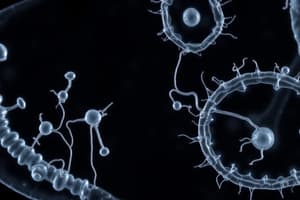Podcast
Questions and Answers
What are spoilage microorganisms and how do they affect food quality?
What are spoilage microorganisms and how do they affect food quality?
Spoilage microorganisms are those that cause undesirable changes in food, affecting flavor, texture, and appearance, ultimately diminishing food quality.
How does microbial growth occur in refrigerated foods?
How does microbial growth occur in refrigerated foods?
Microbial growth in refrigerated foods occurs despite lower temperatures; many spoilage microorganisms can still thrive, leading to quality loss.
Can you name two examples of pathogenic microorganisms that can contaminate food?
Can you name two examples of pathogenic microorganisms that can contaminate food?
Two examples of pathogenic microorganisms are Salmonella and Shigella.
What role do bacteria play in the spoilage of frozen or dried foods?
What role do bacteria play in the spoilage of frozen or dried foods?
What harmful effects do certain microorganisms produce in food prior to consumption?
What harmful effects do certain microorganisms produce in food prior to consumption?
What types of microorganisms are intentionally added to certain foods for beneficial purposes?
What types of microorganisms are intentionally added to certain foods for beneficial purposes?
How does extensive microbial growth remain undetected until quality loss occurs?
How does extensive microbial growth remain undetected until quality loss occurs?
What are the consequences of consuming food contaminated with pathogenic Escherichia coli?
What are the consequences of consuming food contaminated with pathogenic Escherichia coli?
What types of food are typically associated with the activity of useful microorganisms?
What types of food are typically associated with the activity of useful microorganisms?
Why are spoilage microorganisms considered a warning signal for food safety?
Why are spoilage microorganisms considered a warning signal for food safety?
Flashcards
Spoilage Microorganisms
Spoilage Microorganisms
Microorganisms that grow in food, causing undesirable changes in taste, texture, color, and appearance, ultimately making it unfit for consumption.
Pathogenic Microorganisms
Pathogenic Microorganisms
Microorganisms that can make food harmful to humans, either by causing illness or creating harmful toxins.
Useful Microorganisms
Useful Microorganisms
Microorganisms deliberately added to or naturally present in foods to improve their taste, texture, and shelf life.
Food Spoilage
Food Spoilage
Signup and view all the flashcards
Foodborne Illness
Foodborne Illness
Signup and view all the flashcards
Foodborne Toxin
Foodborne Toxin
Signup and view all the flashcards
Foodborne Infection
Foodborne Infection
Signup and view all the flashcards
Food Preservation
Food Preservation
Signup and view all the flashcards
Study Notes
Microorganism Categories in Foods
- Microorganisms associated with foods are categorized as spoilage, pathogenic, or useful.
Spoilage Microorganisms
- Spoilage microorganisms cause undesirable changes in food quality.
- These changes include altered flavor, texture, color, and appearance.
- Bacterial enzymes can cause deterioration in stored foods (frozen or dried).
- Extensive microbial growth (millions per gram or square centimeter) usually occurs before quality loss is noticeable.
- Spoilage alerts consumers to extensive microbial activity.
- Perishable foods (milk, meat, poultry, fish, fruits, vegetables) spoil due to microbial activity at refrigeration temperatures.
Pathogenic Microorganisms
- Pathogenic microorganisms can make food harmful to humans.
- Foods can transmit infectious microorganisms to the gastrointestinal tract (e.g., Salmonella, Shigella).
- Certain microorganisms multiply in foods and produce toxins before consumption (e.g., Clostridium botulinum, Staphylococcus aureus, Bacillus cereus).
- Some microorganisms produce toxins in the human body after consumption (e.g., Clostridium perfringens, certain Escherichia coli).
Useful Microorganisms
- Certain conditions can promote useful microorganisms (e.g., lactic acid bacteria, yeasts).
- These microorganisms are either naturally present or intentionally added.
- Foods like cheeses, yogurt, bread, pickles, and fermented sausages benefit from these microorganisms.
- These foods have enhanced sensory properties and extended shelf life.
Studying That Suits You
Use AI to generate personalized quizzes and flashcards to suit your learning preferences.




